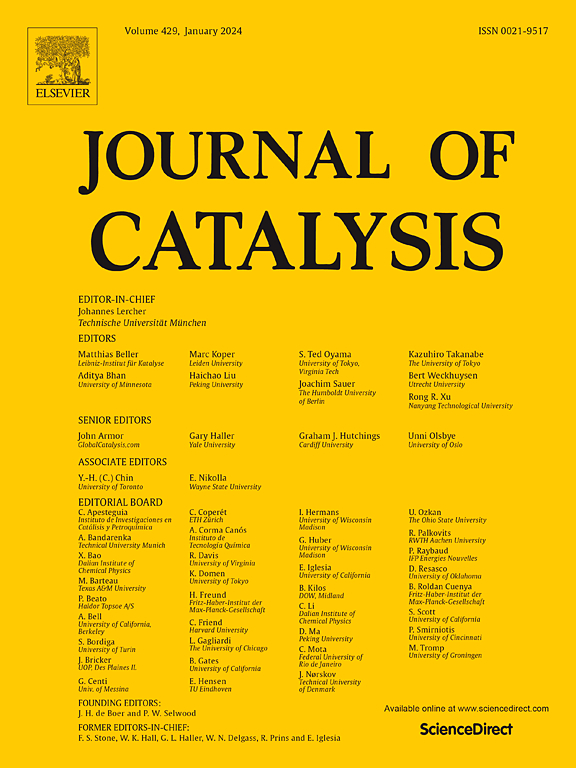Ni catalyst on nanocrystal ZSM-22 boosting the deoxygenation-hydroisomerization of fatty acid to long-chain iso-alkanes with remarkable isomerization selectivity
IF 6.5
1区 化学
Q2 CHEMISTRY, PHYSICAL
引用次数: 0
Abstract
The catalytic conversion of biomass-derived fatty acids into iso-alkanes is a promising approach for producing high-quality renewable biofuels. Herein, Ni catalysts on nanocrystal ZSM-22 (xNi/N-ZSM-22, x represents Ni loading) featuring an abundance of mesoporous structure and numerous accessible 10-member ring (10-MR) openings are prepared, and then tested for converting palmitic acid into long-chain iso-alkanes through a single-step process involving deoxygenation and hydroisomerization reactions. The catalyst with a Ni loading of 3.0 wt% (3.0Ni/N-ZSM-22) demonstrated the highest intrinsic reaction rate (13.6 × 10−4 mol·g−1·h−1) and TOF (14.2 h−1) among xNi/N-ZSM-22 catalysts. This catalyst also exhibited optimal iso-alkanes selectivity of 81.8 % (iso-hexadecanes and iso-pentadecanes), which can be attributed to the efficient synergy between the acid and metal functions. In comparison to a Ni catalyst on conventional ZSM-22 (58.4 %), the superior isomerization selectivity (81.8 %) of the 3.0Ni/N-ZSM-22 is closely related to its abundant mesoporous structure and more accessible 10-MR openings. Moreover, ketonization was identified as a significant pathway for palmitic acid deoxygenation based on kinetic analysis.

纳米晶ZSM-22上的Ni催化剂促进脂肪酸脱氧加氢异构成长链异烷烃,具有显著的异构选择性
催化生物质脂肪酸转化为异烷烃是生产高质量可再生生物燃料的一种很有前途的方法。本文在纳米晶ZSM-22 (xNi/N-ZSM-22, x表示Ni负载)上制备了具有丰富介孔结构和大量可接近的10元环(10-MR)开口的Ni催化剂,并通过脱氧和加氢异构反应的单步过程将棕榈酸转化为长链异构烷烃。在xNi/N-ZSM-22催化剂中,Ni负载为3.0 wt% (3.0Ni/N-ZSM-22)的催化剂表现出最高的本然反应速率(13.6 × 10−4 mol·g−1·h−1)和TOF(14.2 h−1)。该催化剂对异十六烷和异十五烷的选择性为81.8 %,这可归因于酸和金属功能之间的有效协同作用。与传统ZSM-22上的Ni催化剂(58.4 %)相比,3.0Ni/N-ZSM-22的异构化选择性(81.8 %)与其丰富的介孔结构和更容易接近的10-MR开口密切相关。此外,基于动力学分析,酮化反应被确定为棕榈酸脱氧的重要途径。
本文章由计算机程序翻译,如有差异,请以英文原文为准。
求助全文
约1分钟内获得全文
求助全文
来源期刊

Journal of Catalysis
工程技术-工程:化工
CiteScore
12.30
自引率
5.50%
发文量
447
审稿时长
31 days
期刊介绍:
The Journal of Catalysis publishes scholarly articles on both heterogeneous and homogeneous catalysis, covering a wide range of chemical transformations. These include various types of catalysis, such as those mediated by photons, plasmons, and electrons. The focus of the studies is to understand the relationship between catalytic function and the underlying chemical properties of surfaces and metal complexes.
The articles in the journal offer innovative concepts and explore the synthesis and kinetics of inorganic solids and homogeneous complexes. Furthermore, they discuss spectroscopic techniques for characterizing catalysts, investigate the interaction of probes and reacting species with catalysts, and employ theoretical methods.
The research presented in the journal should have direct relevance to the field of catalytic processes, addressing either fundamental aspects or applications of catalysis.
 求助内容:
求助内容: 应助结果提醒方式:
应助结果提醒方式:


